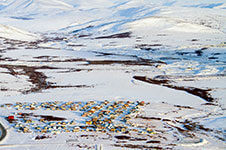On November 4th, Google celebrated the 88th birthday of Nobel-prize winner Charles K. Kao, a physicist and educator considered the “father of fiber optics.” While Kao died in 2018, his legacy continued on as fiber optics continues to support our increasingly digital world and make it possible to connect even the most remote parts of the world to reliable, fast internet service.
In 1964, Kao discovered that glass fibers could conduct information if the glass was purified enough to prevent light from leaking through. Then, in 1966, he and his collaborator George Hockham published a paper on the topic. Kao developed this technology even further in 1977 by creating an optical telephone communication system in downtown Chicago. This system was installed 1.5 miles underground, with fibers that could carry approximately 672 voice channels.
Quintillion is proud to carry on the legacy of engineers like Charles Kao, who paved the way for the fiber optic infrastructure which has revolutionized the world today. It is because of these telecommunications pioneers that we have had the privilege to leave our legacy of creating the first and only subsea and terrestrial fiber optic cable network in the North American Arctic. Today we tip our hats to our predecessors who have helped us achieve a more connected Alaskan community and world.
A Breakthrough in Telecommunication: How Fiber Optic Cables Were Invented
From the moment after the first telephone was created by Alexander Graham Bell in 1876, innovators of the 19th century were researching new, improved ways to transfer telephone messages across great distances. The first telephones were not connected to a network and only included two phones connected by a single phone line. However, Thomas Edison launched the first commercial telephone exchange only two years later, which ran by an electrical voltage carried through copper cables.
However, it was Bell, and not Edison, who discovered that a voice signal could be transmitted using light beams. He created what he called the “Photophone.” Later, Henry Saint-Rene, a French engineer, attempted building a television in 1895 that used bent glass rods to guide light images.
Prior to Kao’s discovery that purified glass could be used to effectively carry data at a high speed, optical fibers were used primarily in medical applications to help doctors better access and visualize their patients’ internal body cavities.
Nonetheless, after Kao’s breakthrough, researchers began experimenting with fused silica on how to create a purified form of glass. In 1970, Robert Maurer, Donald Keck, and Peter Schultz, all from Corning Glass, developed an extremely pure form of glass. They called it “Optical Waveguide Fibers,” and used it to make the first fiber-optic cables. These cables had a capacity 65,000 times greater than that of copper and could carry information thousands of miles away.
Fiber Optics Takes Off: The United States Spearheads the Movement
The first use of fiber optics for commercial purposes was in Long Beach, California. The technology was used by General Telephone and Electronics to process telephone traffic in 1977. This started a fiber optic movement that led telephone companies to rebuild their communication infrastructure to be run off fiber optics. In the mid-1980s, Sprint was the first to create a digital network that ran completely on fiber. In 2000, more than 80% of the world’s long-distance communication traffic was carried over optical fiber cables.
Subsea Fiber Optics Cables: Connecting the World With Fiber
In 1980, the first submarine optical cable was invented, which opened the possibilities for using fiber optics. However, this wasn’t the first time cables were laid along the ocean floor for telecommunication purposes. The first recorded use of an undersea cable system was in 1856, which was a trans-Atlantic telegraph cable made from seven copper conductor wires wrapped in rubber, tarred hemp, and strands of iron.
This system was ineffective and short-lived. The development of in-line amplifiers, or repeaters, made subsea cables more effective by propagating signals to farther distances. These systems were also advanced with the invention of branching units, which allow a single cable system to connect to several end locations (as opposed to the cables simply spanning from one point to another).
Making Subsea Fiber Optic Cables More Resilient
When subsea cables are laid on the ocean floor, it is possible for outside factors to damage or interfere with them. For instance, there have been reports of sharks and crabs being attracted to and attacking submarine cables. Fish trawlers have also been known to cut cables. One way companies like Quintillion are avoiding this issue and better protecting subsea cables is by burying them deep beneath the seafloor.
Modern Advancements in Fiber Optics
The world today depends greatly on the digital atmosphere. With people, businesses, and systems all over the world requiring fast internet and communication services to continue running at a high speed, fiber optics has become a necessity.
Fiber offers many great benefits, including a high bandwidth capacity, low latency, high reliability, and a long lifespan. This infrastructure is well-designed to meet the needs of today’s broadband needs. While there are some challenges, including figuring out the logistics of large-scale trenching and installation projects, fiber optics has shown immense promise in addressing current issues in connectivity.
One current area of research in fiber optics is the transition to All-Optical Networks, or AON. These networks eliminate the need for traditional electronic devices to provide internet, such as routers, processors, and switches. Instead, they work on a photonic network and offer benefits such as almost infinite bandwidth and reduced electrical power and cooling.
The Expansion of Fiber Optics: Connecting the Arctic
In remote areas of the world, especially those that have harsh landscapes and extreme weather conditions, it has always been a challenge to install the infrastructure necessary to access the internet. There has been a global push to expand the world’s current fiber optic cable system and offer more reliable internet to even the most inaccessible sections of the world.
One of the best examples of this is the Quintillion Network. The North American Arctic is a harsh, cold environment that is difficult to install copper or fiber cables in. For this reason, people living in rural communities of Alaska have struggled with accessing reliable internet services for a long time.
This has negatively impacted the lives of Alaskans in these areas. They are unable to quickly access emergency services. In addition, it prevents them from easily streaming videos and movies at home. It also makes it difficult to join teleconferences while working remotely or partaking in distance learning.
In 2017, Quintillion took the first major step toward addressing this issue by building a subsea and terrestrial fiber optic cable that spans 1700 miles in the Northwest and North Slope Arctic Region of Alaska. This network has already connected 1000s of Alaskans to high-speed internet from their own homes. It also enables businesses, schools, hospitals, emergency facilities, emergency services, local governments, and other organizations to revolutionize the way they serve their communities.
And the future has even more in store. Quintillion is currently working on expanding its system further into other parts of Alaska, higher into the North American Arctic, and across the ocean to other continents. A fiber optic system that connects Alaska to both Japan and Europe isn’t just a dream – it’s a mission and goal that is actively being worked on by our team today.
You don’t want to miss what’s coming next. Contact us to learn what’s in store.















